
The new baby rhino
צילום: מוטי קמחי
Ramat Gan Safari welcomes yet another baby rhino
Tanda the white rhinoceros gave birth to her fourth calf after a year-and-a-half-long pregnancy; baby daddy Atari had the honor after fighting and defeating alpha male Tzion.
Congratulations are in order for Tanda, a white rhinoceros, who gave birth to a baby rhino at the Ramat Gan Safari last Friday.
The 23-year-old rhino moved to the safari from the Jerusalem Biblical Zoo in 2005 and mated with Atari, a 36-year-old male rhino.
In 2007, she gave birth to a male calf called Tibor, in 2012 she had her second male calf Terkel, and in 2014 she had a female calf named Teshi.
It is tradition at the Ramat Gan Safari to give the rhino baby a name starting with the same first letter as the mother's name—in this case, the letter T. The four options being considered are Tandai (which means "thanksgiving"), Tamo (which means "sweet"), Tamoka (which means "morning") or Topak (which means "warrior").
Last February, 28-year-old Tzion, the alpha in the safari's rhino herd, was documented fighting against Atari for Tanda.
"Despite the fact Tzion is the alpha male, he must not be able to do his job, and in recent years, Atari managed to steal all of the mating opportunities," Rami Tam, the head of the African Animals Department at the Ramat Gan Safari, told Ynet.
"This is the fifth calf Tanda and Atari had," he added, noting Tanda had miscarried one male calf.
After a long pregnancy, which lasted for a year and a half, Tanda gave birth to the calf at a private enclosure, where the safari's caretakers could monitor the situation of mother and baby.
"There were preliminary signs ahead of labor: Her udders grew, and she kept away from the other rhinos. These are very sociable mammals who are used to living in pairs or groups of three—they're almost never alone," Tam noted.
"At this stage, when we knew she was going into labor, we drew her into a private enclosure where she had food, water and a bed of hay," he added.
Tanda, he said, will be kept at the private enclosure for a little while after the birth—both so she and her newborn could be monitored closely and to "afford her some quiet from the other rhinos in the herd."
This enclosure, while separate, still allows the other rhinos to smell the new calf and form bonds with him. "His introduction to the herd is very important for the forging of bonds with the rest of the rhinos," Tam explained.
The Ramat Gan Safari is considered one of the more fertile zoos in Europe and Asia, vis-à-vis the reproduction of rhinos under the threat of extinction.
"We've broken a new record of rhinos, and now we have the opposite problem—we have too many male rhinos. To stop them from mating with females they are related to, we're searching for new homes for some of them as part of an international reproduction plan," Tam said.
He noted that rhinos cannot be transferred abroad after they reach the age of 30 as they become too heavy, which makes it dangerous to fly them.
White rhinoceros are the second-largest land mammals after elephants, and could reach up to three tons in weight. The white rhinoceros are in better shape in nature compared to other types of rhinos, some of which face extinction.
The white rhinoceros population in nature is estimated at 19,682-21,077 rhinos. Most of them are located in four countries—South Africa, Namibia, Zimbabwe and Kenya. But while conservation authorities have taken steps to protect them from illegal hunting, their future in the wild is under threat.
According to data from the government of South Africa and the International Union for Conservation of Nature, 1,338 rhinos were hunted in Africa in 2015—1,175 of them in South Africa alone. Between January and May 2016, 363 rhinos were hunted.

















